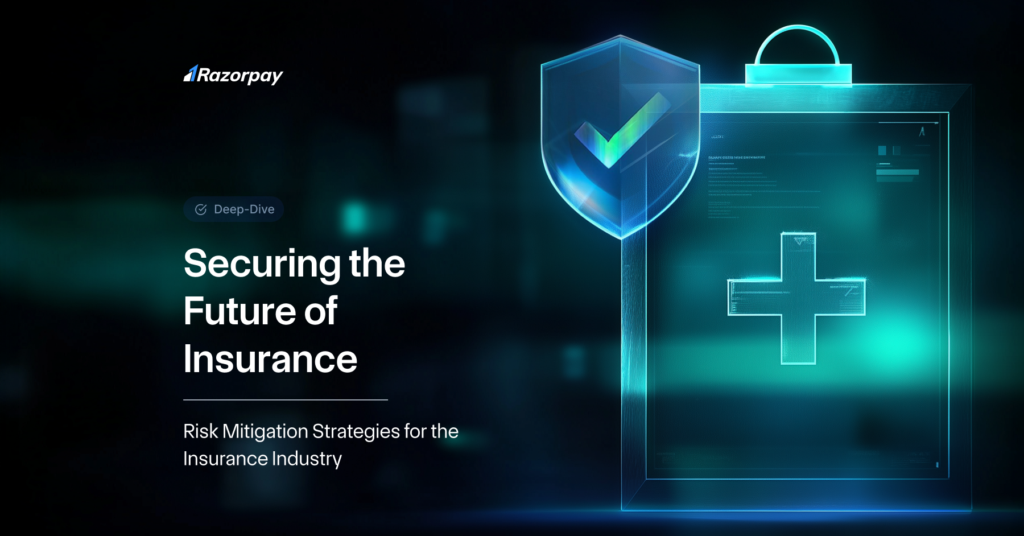Just a few years ago, LIC of India issued over 20.4 million new individual policies, while private insurers added another 8 million, bringing the total to over 28 million new policies in a single year. As more Indians turn to digital platforms to purchase and manage their insurance, the ecosystem has become faster and more accessible than ever.
But with this convenience comes a rising risk. From identity theft to fraudulent claims and policy manipulation, the methods of fraud are becoming more sophisticated. In this new landscape, insurers and merchants must go beyond business-as-usual, rebuilding trust through robust risk frameworks, regulatory alignment, and secure digital systems.
At Razorpay, we’re committed to helping insurers build secure and compliant systems that protect both businesses and policyholders. Here are twelve essential strategies to safeguard your insurance business against fraud.
Best Practices for Fraud Prevention in Insurance
1. Conduct Regular Risk and Solvency Assessments
Perform comprehensive Own Risk and Solvency Assessments (ORSA) at regular intervals to stay ahead of emerging threats. This includes identifying key risks that could impact your ability to meet claims obligations and evaluating whether your capital reserves are sufficient to absorb potential losses. A strong risk assessment framework not only protects the business but also builds long-term trust with policyholders.
2. Comply with IRDAI KYC Guidelines
Ensure strict adherence to IRDAI’s Know Your Customer (KYC) norms for both individuals and juridical entities. For individuals, collect valid identity proof (like Aadhaar, Passport, Driving License, or Voter ID), address proof (such as utility bills or bank statements), and a recent passport-size photograph. For entities, verify legal status, registered address, and authorized representatives.
Leverage accepted KYC methods like Aadhaar-based e-KYC, digital KYC, or video-based identification for a secure and streamlined process. Stay updated with any revisions in IRDAI policies and implement changes promptly to remain compliant.
3. Strengthen Policyholder Verification
Thoroughly verify the identity of every policyholder using the details they’ve provided, in line with regulatory standards. Go a step further by reviewing their claim history and any other supporting documentation to identify inconsistencies or red flags before issuing a policy.
Additionally, confirm the accuracy of contact information to prevent the use of fictitious or stolen identities. A robust verification process serves as the first line of defense against fraud.
4. Ensure Clarity on Policy Validity, Benefits & Claim Process
Merchants must clearly communicate key policy details to policyholders right from the start. This includes:
Coverage Duration & Refunds: Clearly specify the start and end dates of the insurance coverage. In case of cancellations within the cooling-off period, outline refund terms — whether full, partial (after deducting costs like medical check-ups, stamp duty, platform fees), or nil, as per the merchant’s policy.
Renewal Terms: Explain the renewal process, along with any timelines or conditions that policyholders need to meet.
Coverage and Exclusions: Define what the policy covers, including limits or sub-limits, and also list any exclusions to avoid ambiguity during claims.
Claim Procedure: Provide a simple, step-by-step guide on how to initiate and process claims, including the necessary documentation.
In the Event of Demise: Clearly state how claims will be processed in the event of the policyholder’s death. As per IRDAI guidelines, the insurer must verify the nominee’s details and settle the claim in accordance with the policy terms.
Merchants may define their own policy structures, but these must always align with IRDAI regulations to ensure compliance and protect policyholder interests.
5. Define Fair and Transparent Cancellation Policies
Both policyholders and insurers must be informed of their rights and responsibilities when it comes to policy cancellations:
Cancellation by Policyholder: A policyholder should be able to cancel their policy at any time by notifying the insurer. If no claims have been made, they are entitled to a refund of the unused portion of the premium for the remaining policy period.
Cancellation by Insurer: Insurers may only cancel a policy in cases of proven fraud, misrepresentation, or lack of cooperation by the policyholder. Even in such cases, a clear notice period — typically a minimum of 15 days — must be provided.
Clear communication of cancellation terms helps build transparency and trust, reducing the likelihood of disputes.
6. Offer a Clearly Defined Free-Look Period
Introduce a standardized cooling-off period — typically between 0 to 15 days — during which policyholders can cancel their insurance policies with minimal or clearly defined charges. This not only empowers customers to reconsider their decisions but also serves as a buffer to detect and halt potentially fraudulent transactions early.
7. Strengthen Credit Risk Management
Implement thorough creditworthiness checks for clients and partners to assess financial reliability. This reduces the risk of defaults and protects the financial stability of the insurance ecosystem. A well-structured credit evaluation process can help mitigate long-term financial losses.
8. Embrace Technological Innovations like Blockchain
Integrate blockchain technology into policy issuance and claims processing to enhance transparency, traceability, and security. Blockchain’s decentralized nature helps prevent tampering, ensures accurate records, and fosters greater trust among all stakeholders — from policyholders to insurers.
9. Enable Merchant-Initiated Refunds for Fraudulent Transactions
Allow merchants to process refunds swiftly in cases of confirmed fraud. Quick reimbursements not only help victims recover their funds without unnecessary delays but also reinforce customer trust in the insurer’s commitment to fair practices and protection.
10. Prepare for Disasters and Force Majeure Events
Develop a proactive disaster preparedness strategy to protect assets and policyholders in the event of natural calamities or unforeseen events:
Strategic Relocation: Relocate high-value assets or provide guidance for clients in vulnerable areas to minimize exposure to risks such as floods, earthquakes, or cyclones.
Collaborate with Emergency Services: Partner with private firefighting agencies and disaster response teams to offer additional protection for insured properties, especially in wildfire-prone zones.
Building resilience in advance can significantly reduce claim volumes and financial impact during large-scale emergencies.
11. Prioritise Regulatory Compliance and Collaboration
Maintaining compliance with insurance regulations is essential — but going a step further can strengthen resilience and trust:
Public-Private Partnerships: Collaborate with government bodies to build frameworks that can address large-scale or uninsurable risks, ensuring broader protection for customers.
Active Regulatory Liaison: Stay in close contact with regulatory authorities to adapt swiftly to evolving rules, maintain compliance, and uphold industry standards.
Proactive engagement with regulators not only ensures legal alignment but also builds credibility and future-readiness.
12. Implement Advanced Security Protocols
Robust security measures are essential to protect sensitive customer and transaction data:
Encryption & Tokenization: Use advanced encryption standards and tokenization techniques to secure payment information, ensuring that even in the event of a breach, data remains unreadable and unusable.
Two-Factor Authentication (2FA): Enable 2FA for merchant account logins to add an extra layer of security. This significantly reduces the risk of unauthorized access and strengthens trust in your platform.
13. Strengthen Fraud Detection and Prevention
Early detection and swift response are key to reducing fraud-related losses and maintaining customer trust:
Real-Time Monitoring with ML: Implement machine learning algorithms to monitor transactions in real-time. This helps detect unusual patterns and flag potentially fraudulent activities before they escalate.
Proactive Chargeback Management: Reduce chargebacks by improving customer communication, offering flexible refund options, and resolving disputes quickly. A proactive approach helps protect revenue and preserves customer relationships.
14. Ensure Strong Customer Support and Clear Refund Policies
A seamless support experience can make all the difference during critical moments for policyholders:
Robust Multi-Channel Support: Offer responsive customer service across multiple touchpoints — including chat, email, and phone — to resolve issues promptly.
Clear Refund & Cancellation Policies: Communicate refund and cancellation terms transparently. Ensure customers know their rights, timelines, and what to expect in case of cancellations or disputes.
Clarity and accessibility build customer confidence and reduce friction when problems arise.
15. Adhere to IRDAI and Insurance Ombudsman Guidelines
Ensuring fair treatment and transparency is fundamental in the insurance space:
Insurer Responsibilities:
Maintain a dedicated grievance redressal cell to address customer complaints swiftly and fairly.
Clearly communicate the reasons for any claim denials, along with next steps for filing a grievance.
Role of the Insurance Ombudsman:
Acts as an alternative dispute resolution body for policyholders.
Handles complaints related to individual policies, group insurance, and policies held by sole proprietorships and micro-enterprises.
Compliance with these frameworks ensures accountability, protects customer interests, and fosters long-term trust.
To Sum Up…
The insurance industry is built on trust. By adopting these proactive strategies, you can safeguard your business, serve your policyholders better, and stay fully compliant with regulatory standards. A secure insurance experience is not just a competitive advantage, it’s a necessity.


